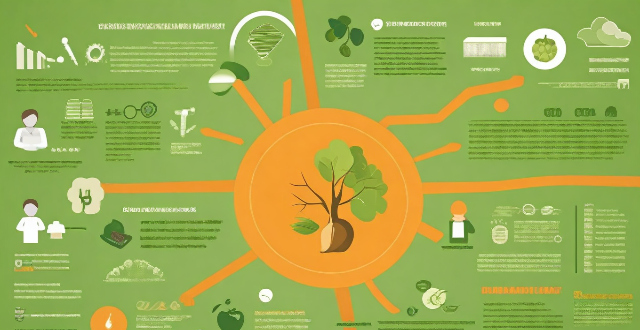Farmer Help

What measures can be taken to reduce agricultural water consumption ?
Agriculture is the largest consumer of water worldwide, accounting for approximately 70% of global freshwater withdrawals. Reducing agricultural water consumption is crucial for sustainable water management and food security. Here are some measures that can be taken to achieve this goal: 1. **Improved Irrigation Systems** - Drip irrigation delivers water directly to the root zone of plants, reducing waste through evaporation and runoff. - Sprinkler irrigation uses pipes or hoses to spray water over crops, allowing more precise control than surface methods. - Micro-irrigation includes drip tapes and micro-sprayers, which apply water slowly and directly to plant roots. 2. **Water-Saving Technologies** - Soil moisture sensors help farmers determine when and how much to irrigate based on soil moisture levels. - Weather stations provide data on rainfall, temperature, and humidity, enabling farmers to adjust irrigation schedules accordingly. - Automated control systems allow for real-time adjustments in irrigation based on sensor information. 3. **Efficient Crop Management** - Crop rotation helps maintain soil health and reduces water demand by alternating between high and low water-consuming crops. - Planting cover crops protects soil from erosion and improves its ability to retain moisture. - Intercropping leads to efficient use of resources, including water. 4. **Soil Health Management** - Composting adds organic matter, improving soil structure and making it better at holding water. - Minimal tillage helps maintain soil structure, reducing water loss through evaporation. - Mulching covers soil with layers of organic material, conserving moisture by reducing evaporation. 5. **Water Pricing and Policies** - Volumetric pricing encourages conservation among farmers by charging for water based on actual usage. - Subsidies for water-saving technologies promote adoption of water-efficient practices. - Regulations limiting excessive water extraction can drive efficiency improvements. 6. **Rainwater Harvesting** - Catchment systems collect rainwater from roofs or other surfaces for later use in irrigation. - Berms and swales divert runoff into fields or storage areas for future irrigation needs. 7. **Education and Training** - Extension programs provide farmers with knowledge about water-saving techniques through workshops and demonstrations. - Farmer field schools offer hands-on training sessions where farmers learn best practices directly in their fields. 8. **Genetic Improvement of Crops** - Drought-resistant varieties develop crop varieties that require less water without sacrificing yield. - Breeding programs enhance crops through selective breeding to increase their water use efficiency. 9. **Integrated Pest Management (IPM)** - Biological control methods reduce the need for water-intensive pesticide applications using natural predators. - Cultural practices like crop rotation and intercropping also help control pests naturally. 10. **Land Leveling** - Terrace construction on sloping lands helps retain water and prevent runoff. - Land leveling equipment ensures even water distribution during irrigation. By implementing these measures, agriculture can become more water-efficient, ensuring there is enough water available for both current and future generations while maintaining agricultural productivity.

Is climate-smart technology affordable for smallholder farmers ?
Climate-smart technology is essential for farmers to adapt to climate change, but its affordability is a concern for smallholder farmers. Key factors influencing affordability include the cost of technology, access to financing, potential returns on investment, the need for training and education, and market access. Governments can offer subsidies and grants, while microfinance institutions provide tailored loans. Partnerships and research focused on local conditions can also make technology more affordable. Capacity building initiatives like extension services and community workshops further support farmers in adopting these technologies. Addressing these factors can help smallholder farmers benefit from climate-smart technology.

How does climate variability impact agriculture and food security ?
Climate variability significantly impacts agriculture and food security by affecting crop yields, livestock production, and the availability and accessibility of food. Direct impacts include changes in temperature, precipitation, extreme weather events, and CO₂ levels, while indirect impacts involve pest and disease outbreaks, water resource availability, soil quality, ecosystem services, market prices and trade, food accessibility and nutrition, and farmer livelihoods. Mitigation and adaptation strategies such as crop diversification, improved water management, breeding resilient crops, sustainable soil management, early warning systems, insurance and safety nets, policy support, and international cooperation are essential for building a climate-resilient food system.

Are there any foods that can help alleviate stress ?
The text provides a summary of foods that can help alleviate stress, including dark chocolate, avocado, blueberries, salmon, and chamomile tea. Each food is explained in terms of its benefits and recommended intake. The article emphasizes that while these foods may help reduce stress levels, they should not be used as a substitute for professional medical advice or treatment.

Does lifting weights help with weight loss ?
Weight loss is a common goal for many people, and weightlifting is one of the most popular methods. However, does lifting weights help with weight loss? This article explores the benefits and drawbacks of weightlifting as a means of weight loss. One of the main benefits of weightlifting is muscle growth, which can lead to an increase in metabolism and help with weight loss. In addition, weightlifting can also help with fat burning and improved cardiovascular health. However, there are also some potential drawbacks to weightlifting, including high initial costs, potential injuries, and a significant time commitment. If you are interested in trying weightlifting as a way to lose weight, make sure you do your research and find a program that fits your needs and lifestyle.

Can ESG principles help mitigate climate change ?
ESG principles, which stand for Environmental, SocialESG principles, which stand for Environmental, Social, have become increasingly important in These principles aim to encourage companies to operate in a more sustainable and socially responsible manner. In this context, it is worth exploring whether these principles can help mitigate climate change. The environmental aspect of ESG focuses on reducing the negative impact of business operations on the environment. This includes reducing greenhouse gas emissions, conserving natural resources, and minimizing waste generation. By promoting these practices, ESG principles can contribute to mitigating climate change in several ways: * Reducing Carbon Emissions: Companies that prioritize environmental sustainability are likely to reduce their carbon footprint by using renewable energy sources, improving energy efficiency, and investing in low-carbon technologies. This can help lower global greenhouse gas emissions, which are a major driver of climate change. * Conserving Natural Resources: By promoting sustainable resource management, ESG principles can help reduce deforestation, protect biodiversity, and conserve water resources. These actions can help maintain the health of ecosystems that play a crucial role in regulating the Earth's climate. * Minimizing Waste Generation: Encouraging companies to adopt circular economy models and reduce waste generation can help reduce the amount of greenhouse gases produced during waste disposal processes. Additionally, recycling and reusing materials can help conserve natural resources and reduce the need for new raw material extraction, further contributing to climate change mitigation. The social aspect of ESG focuses on promoting fair labor practices, human rights, and community involvement. While these principles may not directly address climate change, they can indirectly contribute to mitigating its effects by fostering a sense of corporate responsibility and encouraging companies to invest in their communities. This can lead to increased awareness and action around climate change issues, as well as support for policies and initiatives aimed at addressing the problem. The governance aspect of ESG emphasizes transparency, accountability, and ethical behavior within a company's management structure. By promoting good governance practices, ESG principles can help ensure that companies are held accountable for their environmental impact and are more likely to adopt sustainable business strategies. This can lead to increased transparency around carbon emissions reporting, better alignment between corporate goals and climate objectives, and improved stakeholder engagement on climate-related issues. In conclusion, ESG principles can certainly help mitigate climate change by promoting environmentally sustainable business practices, fostering a sense of corporate responsibility, and ensuring transparency and accountability within companies' management structures. However, it is important to note that these principles alone may not be sufficient to fully address the complex challenges posed by climate change. A comprehensive approach involving government policies, international cooperation, and individual actions will also be necessary to achieve meaningful progress in mitigating the effects of climate change.

Can sport monitoring technology help prevent injuries ?
Sport monitoring technology has become increasingly popular in recent years, with many athletes and coaches using it to improve performance and prevent injuries. This technology includes wearable devices such as fitness trackers, heart rate monitors, and GPS tracking systems, as well as more advanced technologies like motion capture systems and force plates. Sport monitoring technology works by collecting data on an athlete's movements, heart rate, and other physiological factors. This data is then analyzed to provide insights into the athlete's performance and identify areas where they may be at risk of injury. By tracking an athlete's movements and physiological factors, sport monitoring technology can identify potential injury risk factors early on, help coaches create personalized training plans for each athlete based on their individual needs and abilities, monitor recovery periods between sessions, and educate athletes and coaches about injury prevention strategies. Overall, there is evidence to suggest that sport monitoring technology can help prevent injuries in several ways. However, it is important to note that no technology can completely eliminate the risk of injury, and proper training, conditioning, and safety measures should always be prioritized.

What are some examples of successful gender-responsive climate policies or initiatives ?
Gender-responsive climate policies and initiatives are crucial for ensuring that everyone can participate fully in efforts to mitigate and adapt to climate change. Successful examples include women's participation in renewable energy programs, gender-responsive disaster risk reduction programs, and gender-responsive agriculture and food security initiatives. These initiatives provide employment opportunities, reduce vulnerabilities, and improve agricultural practices while considering the needs and priorities of both women and men.

Can exercise help manage symptoms of ADHD ?
Exercise can be a powerful tool in managing symptoms of ADHD by improving focus, reducing impulsivity, increasing energy levels, and promoting better sleep. Choosing the right type of exercise, setting realistic goals, and creating a consistent routine are essential for reaping the full benefits of physical activity for ADHD management.

How does exercise help in managing stress ?
Stress is an inevitable part of life, but regular exercise can help manage it effectively. Exercise releases endorphins, reduces muscle tension, improves sleep quality, boosts self-esteem and confidence, provides a sense of accomplishment, and promotes social interaction. To incorporate exercise into your daily routine, start slowly, find an activity you enjoy, make it a part of your routine, mix up your routine, and don't overexert yourself. By doing so, you can reap the numerous benefits of exercise for stress management and overall well-being.

Can certain foods help reduce inflammation in athletes
Certain foods can help reduce inflammation in athletes. These include anti-inflammatory spices, fruits and vegetables, whole grains, healthy fats, and protein. It's also important to avoid processed foods, sugary drinks, and red meat. By eating a balanced diet full of healthy foods, athletes can reduce inflammation and improve their performance.

What are the most sustainable and eco-friendly jobs available today ?
The most sustainable and eco-friendly jobs available today include renewable energy specialist, environmental scientist, sustainability manager, green building architect/designer, and organic farmer/gardener. Renewable energy specialists work in industries such as solar, wind, hydro, and geothermal power generation to reduce reliance on non-renewable sources of energy. Environmental scientists study natural environments and how human activities affect them, developing solutions for environmental problems such as pollution control, waste management, and conservation efforts. Sustainability managers oversee an organization's efforts to reduce its environmental impact while maintaining profitability. Green building architects/designers specialize in designing buildings that minimize their environmental impact while providing comfortable living spaces. Organic farmers/gardeners grow crops without using synthetic pesticides or fertilizers, relying on natural methods such as crop rotation, composting, and biological pest control to maintain healthy soil and produce high-quality food.

Can engaging in sports help with weight management ?
Engaging in sports can help with weight management by increasing calorie burn, improving metabolism, increasing muscle mass, reducing the risk of obesity-related diseases, and providing mental health benefits. However, a healthy diet and lifestyle habits are also essential for long-term success.

What policies are needed to support small-scale farmers dealing with climate change impacts on agriculture ?
Policies to Support Small-Scale Farmers in Climate Change Impacts on Agriculture: 1. **Financial Support and Insurance Mechanisms**: Provide access to credit facilities and crop insurance schemes tailored for small-scale farmers, along with social safety nets during extreme weather events. 2. **Education and Training Programs**: Organize training sessions on climate-smart agricultural practices and sustainable land management, disseminating information through extension services and mobile technology. 3. **Research and Development**: Support research into climate-resilient crop varieties and facilitate the transfer of appropriate technologies to farmers, promoting precision agriculture where feasible. 4. **Infrastructure and Market Access**: Invest in rural infrastructure like irrigation systems and enhance transportation networks, assisting farmers in accessing diverse markets and providing market information. 5. **Land Tenure and Property Rights**: Ensure secure land rights for small-scale farmers and address gender inequalities in property rights, encouraging collective action through farmer groups and cooperatives. 6. **Policy Coherence and Multi-Sectoral Approach**: Align agricultural policies with national climate change strategies, coordinating efforts across relevant sectors and collaborating with international organizations focused on climate adaptation in agriculture.

Can physical therapy help with sports injury recovery ?
Physical therapy is beneficial for sports injury recovery, addressPhysical therapy is beneficial for sports injury recovery, address restoration, injury prevention, and addressing pain management, function restoration, injury prevention, and supporting a safe return to activity. It involves assessment, diagnosis, manual therapy, range of motion exercises, strengthening exercises, stretching, balance training, functional training, gradual increase in activity, and education on injury prevention and home exercise programs.

Can strength training help improve my running performance ?
Strength training is an essential component of any fitness program, including running. It helps to build muscle strength and endurance, which can significantly improve your running performance. Strength training can help increase muscle strength and endurance, improve running economy, reduce the risk of injury, and enhance posture and body alignment. To incorporate strength training into your running routine, start slowly with light weights and gradually increase intensity over time. Choose exercises that target major muscle groups used during running, such as glutes, hamstrings, quadriceps, calves, and core muscles. Incorporate plyometric exercises to improve explosive power and acceleration. Allow sufficient recovery time between sessions to avoid overtraining and potential injuries.

Can team sports help in coping with pressure ?
Team sports can help cope with pressure by developing resilience, building confidence, providing supportive networks, and teaching time management.

How can we create more green jobs to combat climate change ?
Creating green jobs is a crucial step towards combating climate change. This can be achieved through investing in renewable energy, promoting energy efficiency, supporting sustainable agriculture, and protecting natural habitats. Government incentives, public-private partnerships, skills training programs, green building certifications, transportation infrastructure improvements, industrial process optimization, farmer training programs, local food systems, research and development, conservation work, reforestation initiatives, and sustainable land management are some of the key strategies that can help create more green jobs. By working together, we can ensure a sustainable future for generations to come.

How can technology help in managing a sports career ?
Technology plays a crucial role in managing a sports career. It can help athletes improve their performance, track their progress, and stay connected with their fans and sponsors. Here are some ways technology can assist in managing a sports career: 1. Performance Tracking: Wearable devices such as fitness trackers, smartwatches, and heart rate monitors can help athletes track their physical activity, sleep patterns, and overall health. Video analysis software allows coaches and athletes to review game footage, identify areas for improvement, and develop strategies for future competitions. 2. Training Optimization: Virtual Reality (VR) technology can simulate various environments and scenarios, allowing athletes to train in a controlled setting without the risk of injury. Machine learning algorithms can analyze an athlete's training data and provide personalized recommendations for improving performance and reducing the risk of injury. 3. Injury Prevention and Recovery: Biometric data such as heart rate variability, muscle oxygenation, and fatigue levels can help coaches and trainers monitor an athlete's recovery status and adjust their training accordingly. Technological advancements in rehabilitation, such as electrotherapy, ultrasound therapy, and robotic assistance, can aid in faster recovery from injuries. 4. Nutrition and Hydration: Smart water bottles can track an athlete's hydration levels throughout the day and remind them when it's time to drink water. Nutrition apps can help athletes plan their meals, track their calorie intake, and ensure they are getting the necessary nutrients for optimal performance. 5. Communication and Networking: Social media platforms allow athletes to connect with fans, share their experiences, and promote their personal brand. Sports management software can help athletes manage their schedules, communicate with coaches and teammates, and keep track of their finances and sponsorships. 6. Mental Health Support: Mindfulness apps can help athletes manage stress, improve focus, and enhance their mental well-being. Teletherapy services enable athletes to access mental health support remotely, ensuring they have the resources needed to maintain their mental health while on the road or competing abroad.

How does stretching help with recovery after a workout ?
Stretching is crucial for recovery after a workout. It improves blood circulation, reduces muscle soreness and stiffness, enhances flexibility, promotes better range of motion, prevents injury, and reduces stress. Incorporating stretching into your post-workout routine can greatly enhance your recovery process.

How can team sports help in individual skill development ?
Team sports contribute significantly to individual skill development by improving communication skills, enhancing leadership abilities, increasing self-confidence, bettering time management, improving social skills, promoting physical fitness and coordination, providing opportunities to learn from mistakes, and fostering adaptability.

How do sports psychology techniques help with emotion regulation ?
This article explores the importance of emotion regulation in sports performance and how sports psychology techniques can help athletes regulate their emotions. The techniques discussed include self-talk, visualization, goal setting, breathing techniques, and mindfulness meditation. These techniques enable athletes to stay focused, confident, and motivated during competitions, leading to better performances. By incorporating these techniques into their training routines, athletes can learn to manage their emotions effectively and maintain optimal mental states for peak performance.

Can reading about sports help improve one's own athletic performance ?
Reading about sports can enhance athletic performance by providing insights into techniques, strategies, and mental approaches. It helps in technique improvement, mental preparation, and injury prevention. To apply this knowledge, set clear goals, choose relevant resources, practice what you learn, and seek feedback for adjustments.

How does sports medicine help prevent injuries in sports ?
The text discusses how sports medicine helps in preventing injuries in sports by providing athletes with necessary knowledge, skills, and resources for maintaining their health and safety. It outlines key ways such as pre-participation physical examinations, proper warm-ups, strength training programs, correct technique, injury management, and education. These measures aim to identify risks, prepare the body for exercise, enhance fitness levels, promote safe practices, and manage injuries effectively. Overall, sports medicine plays a vital role in fostering a culture of safety and well-being within sports communities.

Can exercise physiology help in managing stress and anxiety levels ?
Exercise physiology plays a significant role in managing stress and anxiety levels by promoting various physiological responses that counteract the negative effects of these conditions on the body. By incorporating regular physical activity into your lifestyle, you can improve your overall mental well-being and reduce the impact of stress and anxiety on your daily life.

How do sports help in the emotional regulation of teenagers ?
Adolescence is a period of significant emotional, physical, and psychological changes. Sports can play a crucial role in helping teenagers regulate their emotions effectively by promoting physical health, developing social skills, building self-esteem and confidence, providing an outlet for emotions, and teaching discipline and responsibility. Encouraging teenagers to participate in sports is an investment in their overall wellbeing and future success.

Can participating in sports activities help reduce loneliness in elderly people ?
Participating in sports activities can help reduce loneliness in elderly people by providing opportunities for social interaction, promoting psychological wellbeing, and offering a sense of purpose and accomplishment. Encouraging elderly individuals to engage in appropriate sports activities can be an effective way to address loneliness and improve their overall quality of life.

How can sports programs help reduce crime rates in urban areas ?
Sports programs can help reduce crime rates in urban areas by providing alternative activities, building community bonds, enhancing personal development and self-esteem, promoting education and career opportunities, and creating safe spaces.

Is it true that exercise can help manage chronic pain conditions ?
Exercise can help manage chronic pain conditions by reducing pain intensity, improving physical function, enhancing quality of life, and increasing energy levels. It is important to consult with a healthcare professional before starting any exercise program and to start slowly, gradually increasing intensity over time while listening to your body's responses.